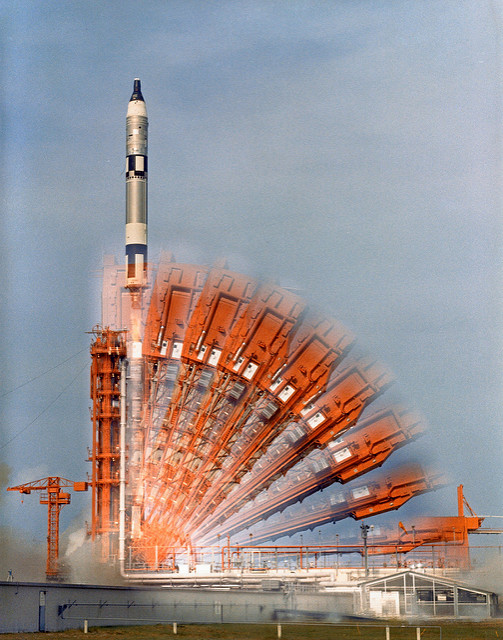News
ICBM rocket shopping: Elon Musk did it in Russia, so why not do it in the United States?
The ultimate goal of launching rockets is to get us exploring and building in space, not picking winners and losers. Simply put, if you can’t compete with the mousetraps on the market, you haven’t actually built a better mousetrap. Repurposed ICBM motors for rocket engines are not the problem.


Gemini 10 launches on a modified Titan ICBM motor. Credit: NASA on The Commons.
A Disagreement Among Star Travelers
There’s a debate going on among the government “powers that be” and commercial space companies over the use of excess intercontinental ballistic missile (ICBM) motors to launch rockets. Currently, these motors are banned from being used for commercial purposes, although military and civil launches are okay.
One side argues that the ban should be lifted because
- the missile parts provide a reliable, cost-effective means for space access; and
- it benefits taxpayers through recouped monies from private sales.
The other side wants the ban maintained because
- flooding the market with cheaper, “off-the-shelf” rocket parts could hinder the innovation and development of new rocket technologies by lowering demand for them; and
- larger companies will take away their market share through easy access to cheaper motors.
This same debate created the ban in the 1990s, and it should be mentioned that the main proponent of lifting the ban was a big part of passing it in the first place. It is also only fair to mention that this main proponent is a very large, established rocket company while the opponents are mostly smaller competitors.
Putting It All Into Perspective
First, it’s important to consider a reality-based context before taking a position on this. Absent another world war, globalization is here to stay, meaning that if a company in the United States cannot offer launch services at a  competitive price point, their potential customers will go elsewhere. Since these customers are not exclusively American companies, U.S. lawmakers cannot simply make the problem go away through legislation by restricting the nationality of launch providers.
competitive price point, their potential customers will go elsewhere. Since these customers are not exclusively American companies, U.S. lawmakers cannot simply make the problem go away through legislation by restricting the nationality of launch providers.
Second, it’s important to frame this issue using marketplace case studies relevant to the situation found here. Old technology is constantly giving way to updated and new technology, demonstrating that innovation is driven by a variety of factors, not just the pure need for a technology to exist.
Finally, it’s important to fully understand the motives of all parties involved. The commercial space industry is, by definition, business-oriented. At a fundamental level, all parties involved are concerned primarily with their own best interest, i.e., their ability to make a profit.
Space Access Should Be More Affordable
In my opinion, the ban should be lifted, as my position on issues like this will always tend towards expanding access rather than restricting it. Achieving democratized space travel will require affordable accessibility to space, and one of the best ways to drive costs down is to not spend valuable resources “reinventing the wheel” if existing resources work well for current needs. This isn’t to say that innovation isn’t necessary, but rather that different  missions have different needs, and the existence of one option doesn’t preclude the need for other options.
missions have different needs, and the existence of one option doesn’t preclude the need for other options.
The car industry is a good case study to compare to. The fact that older cars
exist does not prevent newer, generally improved cars from being developed and sold each year. Gasoline is a proven standard to fuel vehicles, but the demand for electric vehicles is getting louder. It’s the demand for better technology that moves this process of innovation forward.
The companies involved in this debate are profit-driven. What would motivate a company to keep inexpensive, proven technology out of a market they were competing in? In my opinion, the question itself contains the answer. Competition is a proven way to drive development, and the argument that a market flooded with competition would hurt competition has somewhat circular logic.
I do think it is fair to be concerned that the nature of competing against government for a product undermines the concept of a fair market; however, the global nature of launch services and the expanding need for more innovative solutions, i.e., more powerful rocket engines for the upcoming long-distance space missions, mitigate this concern.
 In the current environment, American launch providers are losing business to non-American launch providers, most of which are either heavily subsidized by their governments or are the governments themselves. In order for American launch providers to afford the costs of innovation and development, they need to be able to fairly compete in the global market for a customer base. It is also important to note that the rocket motor is only one part of the process of providing launch services. In that light, opening the ICBM market to American launch providers doesn’t make the American government the competitor as much as it is a retailer selling certain parts which make up a whole rocket product.
In the current environment, American launch providers are losing business to non-American launch providers, most of which are either heavily subsidized by their governments or are the governments themselves. In order for American launch providers to afford the costs of innovation and development, they need to be able to fairly compete in the global market for a customer base. It is also important to note that the rocket motor is only one part of the process of providing launch services. In that light, opening the ICBM market to American launch providers doesn’t make the American government the competitor as much as it is a retailer selling certain parts which make up a whole rocket product.
Elon Musk, Russians, and ICBM Engines (Oh, my!)
To frame this debate in another light, recall that Elon Musk’s initial space dreams involved purchasing ICBM motors from Russia to send dehydrated plant seeds to Mars. He wanted to accomplish something inspirational without diving head first into the business of building rockets. Fortunately for us, SpaceX was born through that process; however,  imagine a future, space-inspired millionaire looking to make a similar contribution except the purpose would ultimately be commercial. Why deny the option of a rocket built with “off-the-shelf” parts? There aren’t many Elon Musk types out there willing to invest most of their own personal fortune for a ten percent chance of success at building a rocket engine from scratch, but every time technology is sent into space, it moves us forward.
imagine a future, space-inspired millionaire looking to make a similar contribution except the purpose would ultimately be commercial. Why deny the option of a rocket built with “off-the-shelf” parts? There aren’t many Elon Musk types out there willing to invest most of their own personal fortune for a ten percent chance of success at building a rocket engine from scratch, but every time technology is sent into space, it moves us forward.
Elon Musk’s ICBM story isn’t the only thing worth noting in this debate. Unfortunately for supporters of the ban, SpaceX essentially renders their argument moot because SpaceX’s innovation and resulting lower launch price tag are what’s making Russian space authorities somewhat cranky about the business they’re usurping from them. Clearly, innovation is still possible even with other ICBM-based rockets on the market.
In Summary
The ultimate goal of launching rockets is to get us exploring and building in space, and this is hindered when the regulatory environment has the effect of hand picking winners and losers. Restricting ICBM motors from being on the commercial market does exactly that. This doesn’t advance the long term goals of space exploration. It only interferes with getting technology into orbit and beyond by restricting the capital available to develop better technology.
 The argument that innovation is hurt by a market full of ICBM motors is one based on a desire to control market forces in an unfair way. Simply put, if you can’t compete with the mousetraps on the market, you haven’t actually built a better mousetrap, and there’s nothing to prevent you from selling existing mousetraps in service packages while you develop better ones.
The argument that innovation is hurt by a market full of ICBM motors is one based on a desire to control market forces in an unfair way. Simply put, if you can’t compete with the mousetraps on the market, you haven’t actually built a better mousetrap, and there’s nothing to prevent you from selling existing mousetraps in service packages while you develop better ones.
Granted, as Elon Musk has reminded us in several interviews, rockets are hard, making the business of rockets even harder. Imagine, however, if the government banned access to all major highways, an existing tax-funded resource, because there was a need for a surface material that was resistant to pot holes and existing asphalt mixes hindered its development. It doesn’t take a rocket scientist to see what a bad idea that would be and what type of impact it would have on those needing the highways to conduct their business, especially while other countries still had their road systems up and running.
Autobahn, anyone?

News
Tesla takes a step towards removal of Robotaxi service’s safety drivers
Tesla watchers are speculating that the implementation of in-camera data sharing could be a step towards the removal of the Robotaxi service’s safety drivers.

Tesla appears to be preparing for the eventual removal of its Robotaxi service’s safety drivers.
This was hinted at in a recent de-compile of the Robotaxi App’s version 25.11.5, which was shared on social media platform X.
In-cabin analytics
As per Tesla software tracker @Tesla_App_iOS, the latest update to the Robotaxi app featured several improvements. These include Live Screen Sharing, as well as a feature that would allow Tesla to access video and audio inside the vehicle.
According to the software tracker, a new prompt has been added to the Robotaxi App that requests user consent for enhanced in-cabin data sharing, which comprise Cabin Camera Analytics and Sound Detection Analytics. Once accepted, Tesla would be able to retrieve video and audio data from the Robotaxi’s cabin.
Video and audio sharing
A screenshot posted by the software tracker on X showed that Cabin Camera Analytics is used to improve the intelligence of features like request support. Tesla has not explained exactly how the feature will be implemented, though this might mean that the in-cabin camera may be used to view and analyze the status of passengers when remote agents are contacted.
Sound Detection Analytics is expected to be used to improve the intelligence of features like siren recognition. This suggests that Robotaxis will always be actively listening for emergency vehicle sirens to improve how the system responds to them. Tesla, however, also maintained that data collected by Robotaxis will be anonymous. In-cabin data will not be linked to users unless they are needed for a safety event or a support request.
Tesla watchers are speculating that the implementation of in-camera data sharing could be a step towards the removal of the Robotaxi service’s safety drivers. With Tesla able to access video and audio feeds from Robotaxis, after all, users can get assistance even if they are alone in the driverless vehicle.
Investor's Corner
Mizuho keeps Tesla (TSLA) “Outperform” rating but lowers price target
As per the Mizuho analyst, upcoming changes to EV incentives in the U.S. and China could affect Tesla’s unit growth more than previously expected.

Mizuho analyst Vijay Rakesh lowered Tesla’s (NASDAQ:TSLA) price target to $475 from $485, citing potential 2026 EV subsidy cuts in the U.S. and China that could pressure deliveries. The firm maintained its Outperform rating for the electric vehicle maker, however.
As per the Mizuho analyst, upcoming changes to EV incentives in the U.S. and China could affect Tesla’s unit growth more than previously expected. The U.S. accounted for roughly 37% of Tesla’s third-quarter 2025 sales, while China represented about 34%, making both markets highly sensitive to policy shifts. Potential 50% cuts to Chinese subsidies and reduced U.S. incentives affected the firm’s outlook.
With those pressures factored in, the firm now expects Tesla to deliver 1.75 million vehicles in 2026 and 2 million in 2027, slightly below consensus estimates of 1.82 million and 2.15 million, respectively. The analyst was cautiously optimistic, as near-term pressure from subsidies is there, but the company’s long-term tech roadmap remains very compelling.
Despite the revised target, Mizuho remained optimistic on Tesla’s long-term technology roadmap. The firm highlighted three major growth drivers into 2027: the broader adoption of Full Self-Driving V14, the expansion of Tesla’s Robotaxi service, and the commercialization of Optimus, the company’s humanoid robot.
“We are lowering TSLA Ests/PT to $475 with Potential BEV headwinds in 2026E. We believe into 2026E, US (~37% of TSLA 3Q25 sales) EV subsidy cuts and China (34% of TSLA 3Q25 sales) potential 50% EV subsidy cuts could be a headwind to EV deliveries.
“We are now estimating TSLA deliveries for 2026/27E at 1.75M/2.00M (slightly below cons. 1.82M/2.15M). We see some LT drivers with FSD v14 adoption for autonomous, robotaxi launches, and humanoid robots into 2027 driving strength,” the analyst noted.
News
Tesla’s Elon Musk posts updated Robotaxi fleet ramp for Austin, TX
Musk posted his update on social media platform X.

Elon Musk says Tesla will “roughly double” its supervised Robotaxi fleet in Austin next month as riders report long wait times and limited availability across the pilot program in the Texas city. Musk posted his update on social media platform X.
The move comes as Waymo accelerates its U.S. expansion with its fully driverless freeway service, intensifying competition in autonomous mobility.
Tesla to increase Austin Robotaxi fleet size
Tesla’s Robotaxi service in Austin continues to operate under supervised conditions, requiring a safety monitor in the front seat even as the company seeks regulatory approval to begin testing without human oversight. The current fleet is estimated at about 30 vehicles, StockTwists noted, and Musk’s commitment to doubling that figure follows widespread rider complaints about limited access and “High Service Demand” notifications.
Influencers and early users of the Robotaxi service have observed repeated failures to secure a ride during peak times, highlighting a supply bottleneck in one of Tesla’s most visible autonomy pilots. The expansion aims to provide more consistent availability as the company scales and gathers more real-world driving data, an advantage analysts often cite as a differentiator versus rivals.
Broader rollout plans
Tesla’s Robotaxi service has so far only been rolled out to Austin and the Bay Area, though reports have indicated that the electric vehicle maker is putting in a lot of effort to expand the service to other cities across the United States. Waymo, the Robotaxi service’s biggest competitor, has ramped its service to areas like the San Francisco Bay Area, Los Angeles, and Phoenix.
Analysts continue to highlight Tesla’s long-term autonomy potential due to its global fleet size, vertically integrated design, and immense real-world data. ARK Invest has maintained that Tesla Robotaxis could represent up to 90% of the company’s enterprise value by 2029. BTIG analysts, on the other hand, added that upcoming Full Self-Driving upgrades will enhance reasoning, particularly parking decisions, while Tesla pushes toward expansions in Austin, the Bay Area, and potentially 8 to 10 metro regions by the end of 2025.







